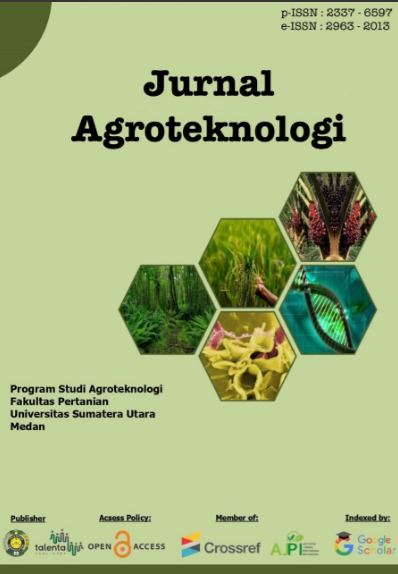Chemical Properties Of Soil On Dry Land After The Eruption Of Mount Sinabung In Kecamatan Payung, Karo
DOI:
https://doi.org/10.32734/ja.v11i3.19921Keywords:
Eruption of mount Sinabung, Soil chemical properties, Kecamatan Payung, Dry landAbstract
This study aims to determine the chemical properties of soil on dry land after the eruption of Mount Sinabung in Kecamatan Payung, Kabupaten Karo. The eruption of Mount Sinabung that occurred from 2010 to 2020, released volcanic ash containing Silica, Aluminum, Sulfur, Magnesium, Sodium, Potassium, Calcium, Iron, Phosphate, and Manganese. Analysis of soil chemical properties was carried out at the Research and Technology Laboratory, Faculty of Agriculture, University of North Sumatra and PT. SOCFINDO. This study used 8 composite soil samples as research material, using survey methods and stratified sampling / grouping by overlaying several maps. Soil pH data analysis using electrometric method, C-organic content with Walkley and Black method, Cation Exchange Capacity (CEC) with NH4OAc extraction method pH 7, P2O5 ex-HCl, K2O ex-HCl, and Base Saturation (KB) with calculations (number of exchangeable base cations / CEC x 100%). The results of soil analysis showed that after the eruption of Mount Sinabung, dry land in Kecamatan Payung had acidic soil pH, high levels of P2O5 ex-HCl, levels of K2O ex-HCl with low to high criteria, levels of organic C tended to be high, soil CEC tended to be high and KB very low soil. Soil fertility status is included in the criteria of low and medium.
Downloads
Downloads
Published
Issue
Section
License
Copyright (c) 2023 JURNAL AGROTEKNOLOGI

This work is licensed under a Creative Commons Attribution-ShareAlike 4.0 International License.
The Authors submitting a manuscript do so on the understanding that if accepted for publication, copyright of the article shall be assigned to Jurnal Online Agroekoteknologi as well as TALENTA Publisher Universitas Sumatera Utara as the publisher of the journal.
Copyright encompasses exclusive rights to reproduce and deliver the article in all forms and media. The reproduction of any part of this journal, its storage in databases and its transmission by any form or media, will be allowed only with written permission from Jurnal Online Agroekoteknologi.
The Copyright Transfer Form can be downloaded here.
The copyright form should be signed originally and sent to the Editorial Office in the form of original mail or scanned document.











